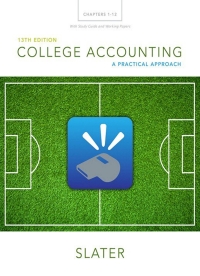Question
1. In its first year of operations a company produced and sold 70,100 units of Product A at a selling price of $21 per unit
1.
In its first year of operations a company produced and sold 70,100 units of Product A at a selling price of $21 per unit and 17,600 units of Product B at a selling price of $41 per unit. Additional information relating to the companys only two products is shown below:
| Product A | Product B | Total | ||||||||||
| Direct materials | $ | 436,800 | $ | 251,900 | $ | 688,700 | ||||||
| Direct labor | $ | 201,000 | $ | 104,500 | 305,500 | |||||||
| Manufacturing overhead | 608,500 | |||||||||||
| Cost of goods sold | $ | 1,602,700 | ||||||||||
The company created an activity-based costing system that allocated its manufacturing overhead costs to four activities as follows:
| Activity | ||||||||||||||||
| Activity Cost Pool (and Activity Measure) | Manufacturing Overhead | Product A | Product B | Total | ||||||||||||
| Machining (machine-hours) | $ | 213,600 | 90,500 | 62,600 | 153,100 | |||||||||||
| Setups (setup hours) | 157,600 | 76 | 310 | 386 | ||||||||||||
| Product design (number of products) | 120,100 | 1 | 1 | 2 | ||||||||||||
| Other (organization-sustaining costs) | 117,200 | NA | NA | NA | ||||||||||||
| Total manufacturing overhead cost | $ | 608,500 | ||||||||||||||
The companys ABC implementation team also concluded that $50,500 and $101,000 of the companys advertising expenses could be directly traced to Product A and Product B, respectively. The remainder of its selling and administrative expenses ($401,000) was organization-sustaining in nature. If the company uses a traditional cost system that relies on plantwide overhead allocation based on direct labor dollars, what is the total gross margin (or product margin) earned by Product A? (Round your intermediate calculations to 2 decimal places.)
Multiple Choice
-
$353,610
-
$414,210
-
$434,310
-
$383,810
2.
Assume the following information:
| Percent Complete | |||||||||||||
| Milling Department | Units | Materials | Conversion | ||||||||||
| Beginning work in process inventory | 200 | 40 | % | 30 | % | ||||||||
| Units started into production during March | 6,200 | ||||||||||||
| Units completed during the period and transferred to the next department | 5,800 | 100 | % | 100 | % | ||||||||
| Ending work in process inventory | 600 | 80 | % | 20 | % | ||||||||
| Milling Department | Materials | Conversion | ||||||
| Cost of beginning work in process inventory | $ | 10,000 | $ | 15,000 | ||||
| Costs added during the period | 290,000 | 383,000 | ||||||
| Total cost | $ | 300,000 | $ | 398,000 | ||||
Using the weighted-average method, the total cost of ending work in process inventory reported on the cost reconciliation report is closest to:
Multiple Choice
-
$34,327.
-
$30,997.
-
$32,237.
-
$30,117.
Step by Step Solution
There are 3 Steps involved in it
Step: 1

Get Instant Access to Expert-Tailored Solutions
See step-by-step solutions with expert insights and AI powered tools for academic success
Step: 2

Step: 3

Ace Your Homework with AI
Get the answers you need in no time with our AI-driven, step-by-step assistance
Get Started


